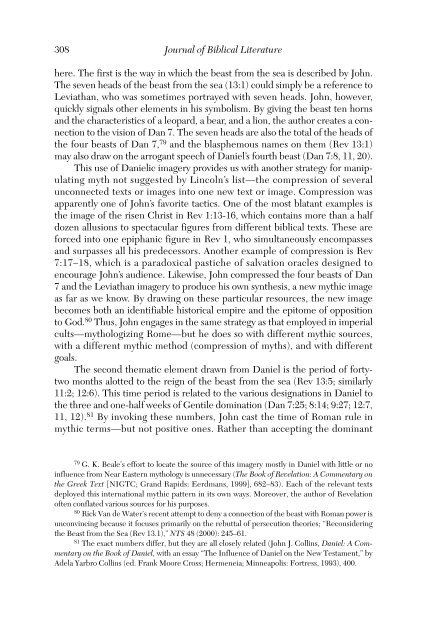Journal of Biblical Literature - Society of Biblical Literature
Journal of Biblical Literature - Society of Biblical Literature
Journal of Biblical Literature - Society of Biblical Literature
Create successful ePaper yourself
Turn your PDF publications into a flip-book with our unique Google optimized e-Paper software.
308<br />
<strong>Journal</strong> <strong>of</strong> <strong>Biblical</strong> <strong>Literature</strong><br />
here. The first is the way in which the beast from the sea is described by John.<br />
The seven heads <strong>of</strong> the beast from the sea (13:1) could simply be a reference to<br />
Leviathan, who was sometimes portrayed with seven heads. John, however,<br />
quickly signals other elements in his symbolism. By giving the beast ten horns<br />
and the characteristics <strong>of</strong> a leopard, a bear, and a lion, the author creates a connection<br />
to the vision <strong>of</strong> Dan 7. The seven heads are also the total <strong>of</strong> the heads <strong>of</strong><br />
the four beasts <strong>of</strong> Dan 7, 79 and the blasphemous names on them (Rev 13:1)<br />
may also draw on the arrogant speech <strong>of</strong> Daniel’s fourth beast (Dan 7:8, 11, 20).<br />
This use <strong>of</strong> Danielic imagery provides us with another strategy for manipulating<br />
myth not suggested by Lincoln’s list—the compression <strong>of</strong> several<br />
unconnected texts or images into one new text or image. Compression was<br />
apparently one <strong>of</strong> John’s favorite tactics. One <strong>of</strong> the most blatant examples is<br />
the image <strong>of</strong> the risen Christ in Rev 1:13-16, which contains more than a half<br />
dozen allusions to spectacular figures from different biblical texts. These are<br />
forced into one epiphanic figure in Rev 1, who simultaneously encompasses<br />
and surpasses all his predecessors. Another example <strong>of</strong> compression is Rev<br />
7:17–18, which is a paradoxical pastiche <strong>of</strong> salvation oracles designed to<br />
encourage John’s audience. Likewise, John compressed the four beasts <strong>of</strong> Dan<br />
7 and the Leviathan imagery to produce his own synthesis, a new mythic image<br />
as far as we know. By drawing on these particular resources, the new image<br />
becomes both an identifiable historical empire and the epitome <strong>of</strong> opposition<br />
to God. 80 Thus, John engages in the same strategy as that employed in imperial<br />
cults—mythologizing Rome—but he does so with different mythic sources,<br />
with a different mythic method (compression <strong>of</strong> myths), and with different<br />
goals.<br />
The second thematic element drawn from Daniel is the period <strong>of</strong> fortytwo<br />
months alotted to the reign <strong>of</strong> the beast from the sea (Rev 13:5; similarly<br />
11:2; 12:6). This time period is related to the various designations in Daniel to<br />
the three and one-half weeks <strong>of</strong> Gentile domination (Dan 7:25; 8:14; 9:27; 12:7,<br />
11, 12). 81 By invoking these numbers, John cast the time <strong>of</strong> Roman rule in<br />
mythic terms—but not positive ones. Rather than accepting the dominant<br />
79 G. K. Beale’s effort to locate the source <strong>of</strong> this imagery mostly in Daniel with little or no<br />
influence from Near Eastern mythology is unnecessary (The Book <strong>of</strong> Revelation: A Commentary on<br />
the Greek Text [NIGTC; Grand Rapids: Eerdmans, 1999], 682–83). Each <strong>of</strong> the relevant texts<br />
deployed this international mythic pattern in its own ways. Moreover, the author <strong>of</strong> Revelation<br />
<strong>of</strong>ten conflated various sources for his purposes.<br />
80 Rick Van de Water’s recent attempt to deny a connection <strong>of</strong> the beast with Roman power is<br />
unconvincing because it focuses primarily on the rebuttal <strong>of</strong> persecution theories; “Reconsidering<br />
the Beast from the Sea (Rev 13.1),” NTS 48 (2000): 245–61.<br />
81 The exact numbers differ, but they are all closely related (John J. Collins, Daniel: A Commentary<br />
on the Book <strong>of</strong> Daniel, with an essay “The Influence <strong>of</strong> Daniel on the New Testament,” by<br />
Adela Yarbro Collins (ed. Frank Moore Cross; Hermeneia; Minneapolis: Fortress, 1993), 400.

















